Jessicann is very sure she -- and other women -- belong at the L.A. Auto Show
When Jessica Chou drove her 2003 Volkswagen Jetta into the Los Angeles Auto Show, the people checking her in seemed confused.
“All the guys were like, ‘Are you sure you belong in here?’ And I was like, ‘Yeah, I know, she’s a real beauty,’ ” Chou said with a laugh.
She may not customize Ferraris with candy-red rims or rear-hinged doors, but the 26-year-old YouTuber from Culver City, known online as “Jessicann,” pitched something perhaps even more novel: Girls’ Garage, which she said is the first female-centric booth in the auto show’s 109-year history.
She raised almost $6,500 on GoFundMe to set up shop.
During the 10-day show, Chou will be explaining everything from how to check your tire pressure to how to make sure your coolant tank is full.
Stop by the Girls’ Garage at the Los Angeles Convention Center and you may snag a photo with her in her Rosie the Riveter photo booth.
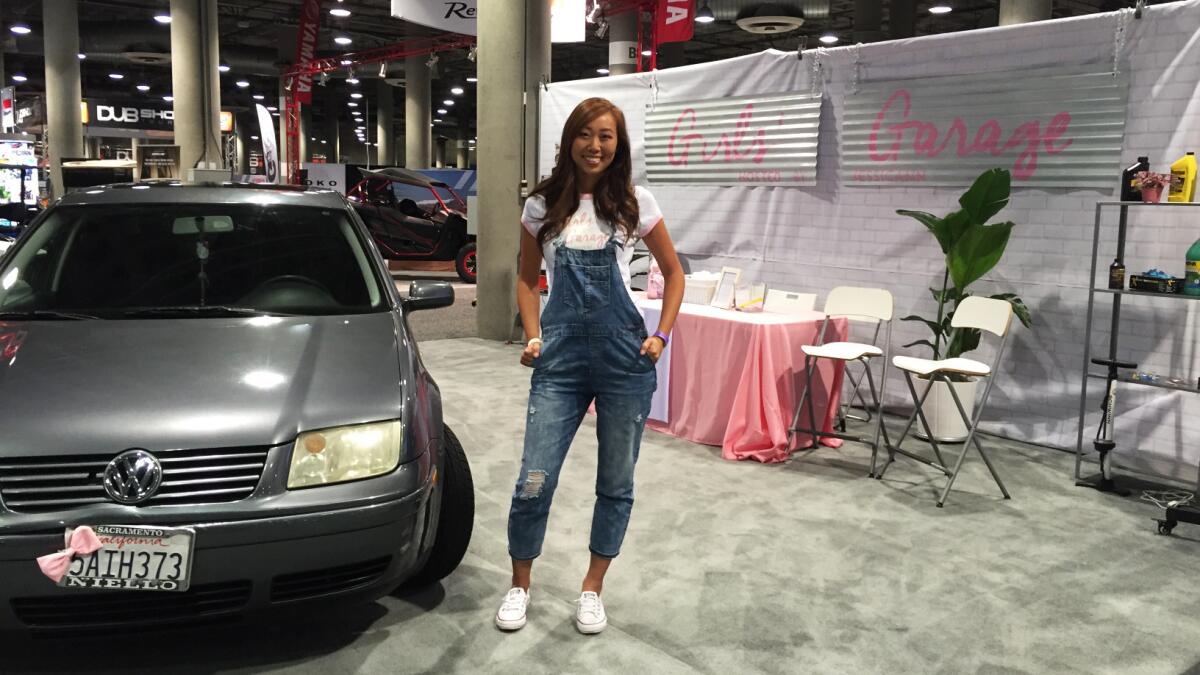
How’d you get started?
Jessicann: There was one really big day for me. I was fixing my spark plugs because my car just broke down and AAA said, “Why don’t you do a tuneup?” I was out on the street fixing my spark plugs and a man walked by and he said, “What are you doing?” I said, “Oh, I’m changing out my spark plugs.” And he said, “By yourself?” I think it was in that instant that I’ve never felt more empowered than to answer, “Yes, by myself!” I was beaming with pride and excitement that I was able to change my spark plugs, and my car was functioning back to normal. I had to find a way to capture this to give other women that feeling of empowerment.
What’s the craziest fix you’ve ever done on your car?
J: My craziest fix was the fuel pump. My car was dead for a whole week, and I had no idea what the problem was. I was searching and searching online, and all signs were pointing to the fuel pump. I needed to buy this crazy tool to be able to take it off. I bought the new fuel pump, changed it out, I held my breath and started the car, and it worked. I could’ve cried tears of joy. I bought the part for, I think, 200 bucks so I saved a lot of money, granted it took me all day.
What was your first fix?
J: My first fix was probably a brake light or something, something simple. But even that is fun, to know that you could do that and not have to go to a shop just to get a little bulb switched out.
What happened when you drove in here today?
J: I pulled in and was like, “I have a booth here.” And they just kind of looked at me funny. I was like, “I know it’s not a Maserati, maybe one year it will be.” But it was really funny. And then we drove past a group of guys and they’re like, “Oh, they’re just letting people in to take pictures?” And I was like, “No, I have a booth here!” But I’m just excited to kind of stir up some commotion because this is the first-ever female-dedicated space here. Which is exciting, it’s about time.
Tell me about your name.
J: I actually hated this nickname in high school. My middle name is Ann, my first name is Jessica, obviously. One of my best friends called me “Jessicann,” and I just hated it so much. When I was thinking of a name for YouTube, I was brainstorming, and “Jessicann” is so positive. It shows that I can do things, and you can too. The word “can” is just so empowering.
What has the response been to your YouTube channel?
J: One of my favorite comments was a dad said that I was his daughter’s new hero, which just, like, made me cry.
What’s one must-have tool for girls who want to learn to fix their cars?
J: I recently bought a service manual for my car. It looks intimidating, almost like an encyclopedia for your car, but it has everything you need to know, step by step. A lot of times, your dealer will tell you, “It’s time to change this.” You can say, “Actually, you don’t have to change it until a year from now.” It’s kind of like my bible now.
This interview has been edited for brevity and clarity.
Among subcompact crossovers, Toyota’s CH-R is a cheaper, edgier-looking option
A subcompact crossover with stand-out-from-the-crowd looks. The CH-R inexplicably stands for Coupe High-Rider, although it rides low and actually has four doors — you can see the rear door handles up near the roof.
A look at a few of the show’s speediest vehicles
Not all the cars are traditional racers.
Not to be outdone, LEGO entered the race with this 375,000-brick Porsche.
Lexus has the ‘hottest’ car of the show: the Sriracha IS
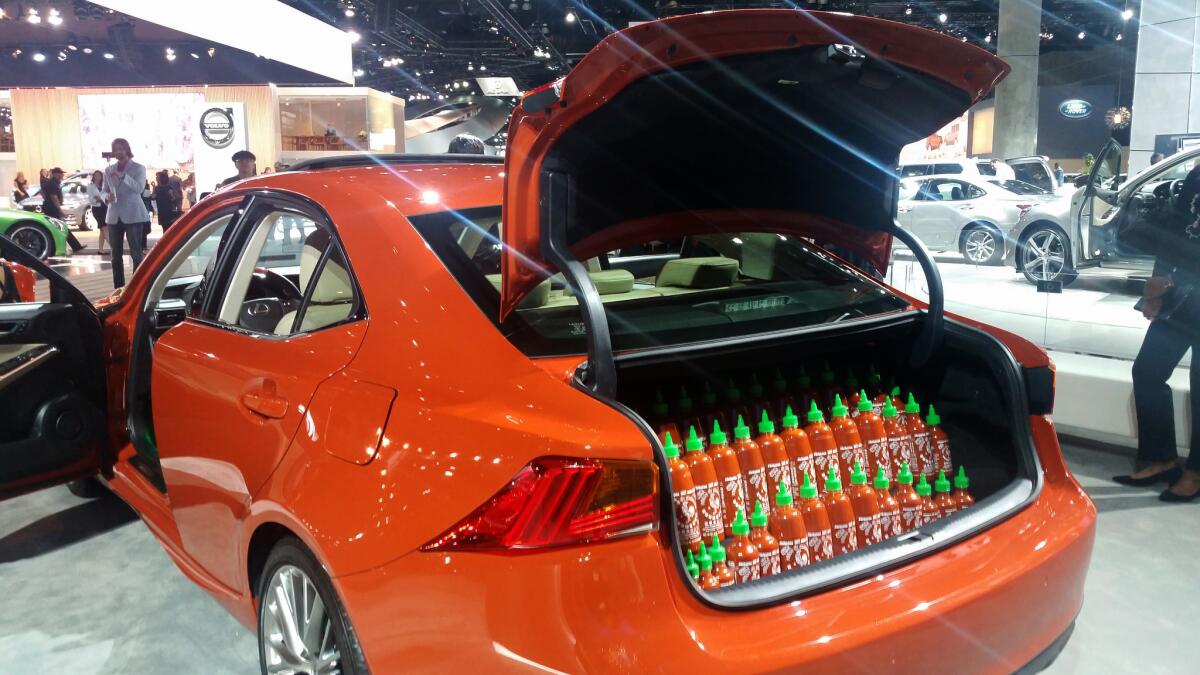
The “hottest” car at this year’s L.A. Auto Show might just be Lexus’ Sriracha IS, a one-off custom creation designed to attract a young market.
Lexus and Huy Fong Foods, both based in Southern California, teamed up to launch the 2017 model of its IS sports sedan, the Lexus’ “entry-level” car, which retails for $37,325.
“It just seemed like a really good fit,”said Laura Conrad, a Lexus spokesperson. “Sriracha has this cult-like following that we were really excited to tap into.”

The car features a number of Sriracha details, including gold flecks in the paint that are supposed to resemble chili flakes. There is actual Sriracha in the steering wheel, 43 bottles in the trunk and — just in case that weren’t enough — an emergency supply of the stuff in the key fob. The temperature and drive settings even have Sriracha options.
The car sports a number of green accents that recall the hot sauce’s signature bottle caps, including the brake calipers, details on the side-view mirrors and ambient light in the car.
Sriracha aficionados can ogle the car as much as they like at the auto show, but no one will be driving it home.
The car isn’t for sale.
To get a taste for how the car was made, check out this video produced by Lexus:
Car company heads say they’re doing all they can to help prevent texting-and-driving accidents
Despite considerable advances in safety equipment and driver assistance systems, traffic deaths in the U.S. are rising. The National Highway Traffic Safety Administration reported recently that road fatalities rose 10% in the first half of 2016 – after an increase in 2015 that was the sharpest in 50 years, when 38,300 people died on U.S. roads, according to the National Safety Council.
Why? NHTSA reported that a 3.3% increase in U.S. miles traveled in the first half of this year – the result of lower gas prices, healthy new car sales and a stronger economy – could not account for the higher number of deaths.
Auto executives at AutoMobility L.A., the industry-only portion of the L.A. Auto Show, believe the rise in deaths is a direct result of distracted driving – namely, texting.
“It comes down to people being distracted, and texting is a big piece of that,” said Ford CEO Mark Fields. “Part of it is more miles being driven, since the recession ended. But part of it is people being distracted.”
“It’s texting,” said Chevrolet head Alan Batey. “We are on the road to autonomous, and our vehicles are supply a lot of safety features. But texting and driving is a very, very bad habit.”
Both executives, speaking to The Times during AutoMobility L.A. interviews, said their companies are doing all they can to design and install safety systems in their automobiles – like lane-keeping assistance, front collision warnings, and emergency braking assistance – to help prevent collisions.
But both emphasized that the human element is the problem.
“We all have a responsibility for this, but computers and machines are just more accurate than humans,” Batey said.
And it’s not just texting.
“I do a little survey, when I’m driving, where I look at the other drivers,” Fields said. “It is amazing to see what people do in their cars.”
Honda and Lego team up with East L.A. children to win Automobility L.A. Design and Developer Challenge
The year is 2050: Two-thirds of the world’s population live in cities, and urban sprawl is rampant. What will our transportation system and cars look like?
This question helped form the basis of the Automobility L.A. Design and Developer Challenge, which invited creative and unexpected collaborations to conceptualize autonomous cars of the future.
Over the last year, teams including Crayola and Qoros; Fandango and Jaunt VR; and Honda, Lego and Trigger designed concept vehicles to showcase at Wednesday’s event.
Some teams, like Kiska and KTM, envisioned a future of deserted cities that were only used for racing vehicles. Another, CH Auto and Creative Mobile, imagined interconnected West Coast cities, forming “Octoangeles.” Their design included three-dimensional travel and seamless interaction between vehicle and human.

Honda, Lego and Trigger, the competition winner, used the power of kids’ imagination to develop their concept.
The team held a brainstorming session with children from the Girls and Boys Club of East L.A., in which designers worked with the kids to create a pod that people can use to live in, work and travel. The design embraced both artificial intelligence and alternative energy.
“We reached out to families to learn what inspires them and used that to craft futures powered by their dreams,” said Martin Sanders, Lego representative.
The team’s collaboration with local kids was one of the reasons for their win, according to competition judges.
While Honda, Lego and Trigger won the “Judges’ Pick” award, voting is now open to industry and media professionals.
Going electric ...
Subaru’s VIZIV-7 is big, and its sales are too
It’s a concept car. The concept? Big. “Subaru is demonstrating its thinking about how big a future Subaru SUV can be,” the company said. At 204.7 x 79.9 x 72 inches, it’s larger than a Ford Flex, and almost as big as Ford’s Expedition monster-mobile. It’s got three rows of seats.
Volvo experiments with app to deliver fuel, car washes, rides to the dealer
It seems like every other car company at the L.A. Auto Show has a new on-demand app to publicize. Most involve small-scale pilot programs.
The latest is Volvo, which Thursday announced Volvo Concierge Services. In San Francisco, 300 Volvo drivers will be invited to join the program, where a tap of the app orders up a car wash, a valet to take the car to the dealer for repair and maintenance, and, to avoid a trip to the gas station, fuel delivery.
Volvo claims the service as “the first expandable digital ecosystem that connects car owners with convenience services via a smartphone app.”
Volkswagen jumps into the midsize sport utility market with the seven-passenger Atlas
This is Volkswagen’s entry into the midsize sport utility market, and the long-awaited, seven-passenger 2018 Atlas is set to go on sale next year. Volkswagen has not yet announced pricing for the Atlas but it’s reportedly expected to be in the $30,000 range.
Chevy introduces the new Colorado ZR2, an off-road-ready pickup

Alan Batey, president of General Motors North America and head of Chevrolet, is big on trucks, and Los Angeles is his biggest market.
The executive, speaking before the launch of Chevy’s new ZR2 off-road-ready pickup truck, said Los Angeles now eclipses Dallas and Houston and every other city in the U.S. for truck sales.
He’s bullish on the ZR2’s chances in the market, and his company’s four-wheeled future.
“We’re doing about 900,000 units in total truck sales for GM,” Batey said. “That made us No. 1 for the year last year, and I think we’ll be No. 1 again this year.”
Chevy trucks are “the lion’s share” of that figure, Batey said, making up about two-thirds of all GM trucks, excluding GMC and Ram units sold.
That compares favorably with sales at Ford, which manufacturers the country’s single most popular vehicle, the F-150 pickup.
“If you look at Ford, from 2013 to now, their truck sales are flat,” Batey said. “Ours are up 35% over the same period.”
Batey said that up to 50% of people who buy a new Colorado, which the company reintroduced as a midsize truck to become the only manufacturer to offer midsize, full-size and heavy-duty trucks, are new to the brand. Conquest sales are taking away customers from Ford’s F-150 and Toyota’s Tacoma.
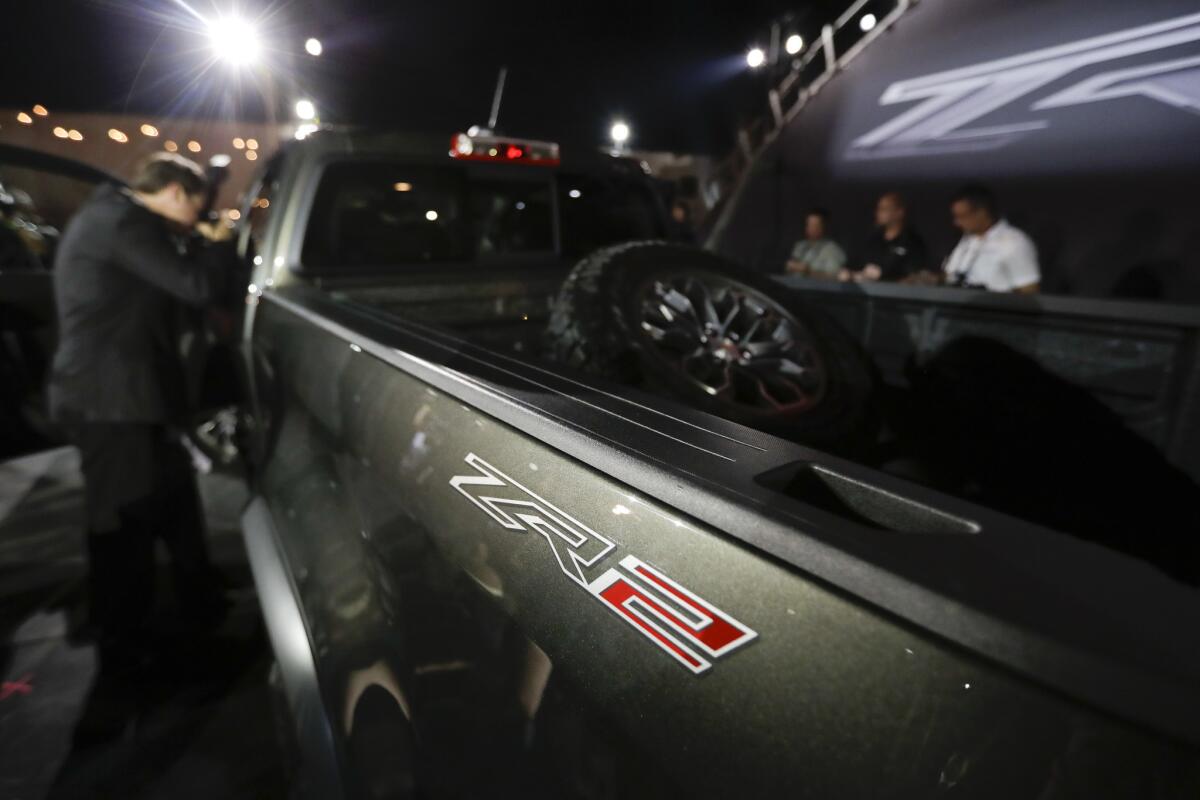
What will the new ZR2 compete with?
Anita Burke, chief engineer for the Colorado line, said she thinks the new rough rider may steal consumers from Nissan’s Pro 4X and Toyota’s TRD Pro.
The new 4x4 truck is built on the same wheel base as its fellow Colorados, but the body is 3.5 inches wider. It comes standard with a skid plate, hood scoop, 31-inch off-road tires, and special suspension built around Multimatic shocks.
It will be powered by either the company’s standard V6 or the Duramax diesel, and be offered as either a crew cab, with a five-foot bed, or with an extended six-foot bed. It will begin appearing in dealers in the spring of 2017.
The Chevy Bolt EV wins Green Car of the Year
The all-electric Chevrolet Bolt EV was named Green Car of the Year at the L.A. Auto Show this morning. The award is given annually by the Green Car Journal and is considered one of the most prestigious awards at the show.
The journal said its editors selected the 2017 Bolt EV for its 238-mile zero-emission driving range, stylish design, driving dynamics and suite of advanced and connected technologies. The car has the distinction of being the first production battery electric vehicle to achieve a 200-plus-mile driving range.
Last year, the award went to the second-generation Chevy Volt, a plug-in hybrid with a 53-mile electric range and 106 MPGe.
The Bolt EV sits high and is shaped like an SUV, with a 288-cell lithium battery that runs under the car and then up under the backseat. It takes about 12 hours to charge on a regular household outlet, said Michelle Malcho, a Chevrolet spokeswoman.
Alan Batey, president of General Motors North America and head of Chevrolet, said he expected the plug-in battery-electric Bolt EV to become a fixture on the Southern California landscape. Los Angeles is the biggest market in the U.S. for the company’s Volt, Batey said. “I think it will be our biggest market for the Bolt EV too.”
The Bolt EV is set to hit showrooms later this year and be available in all 50 states in 2017. With a sticker price of $37,495 for the base model (not including the $7,500 tax credit for which many owners will be eligible), it will be the first mid-priced long-range electric vehicle on the market.
Staff writer Charles Fleming contributed to this report
Alfa Romeo and Maserati add SUVs to their sports and luxury car line-ups
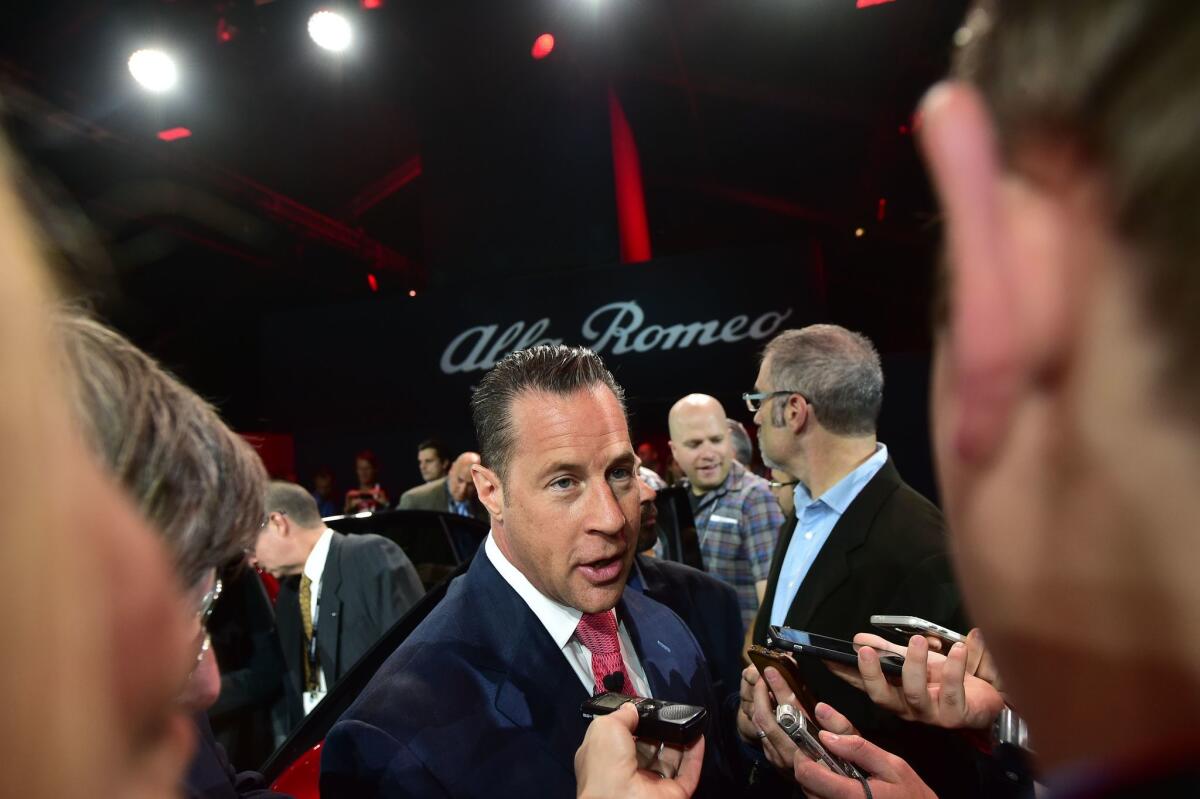
Reid Bigland wears many hats at Fiat Chrysler Automobiles, as head of U.S. sales and as boss of both Alfa Romeo and Maserati brands.
He was wearing his Italian headwear at AutoMobility LA, the run-up to the Los Angeles Auto Show, where he was performing U.S. introductions for new SUV models from both subsidiaries.
The SUVs are firsts for the two brands, Maserati’s Levante making its first appearance at the auto show and Alfa Romeo’s Stelvio getting its world debut on the AutoMobility stage.
The two Italian nameplates are trying to raise brand awareness by adding an SUV to their sports car and luxury car line-ups, and to bring new buyers to the brand by giving them a vehicle they find more useful than, say, an Alfa Romeo 4C racer or a Giulia.
Bigland dismisses questions that the two brands are coming late to an expanding SUV market that may have expanded to capacity. “We don’t think it’s too late by any means,” he said. “The exodus away from passenger cars is not abating. The segment is hot.”
Levante sales, so far, support his optimism. Maserati’s year to date numbers for 2016 are up 16% over 2017, Bigland said, while global September, October and November sales are showing rises of 50% to 60% over last year.
“Levante is playing a big role in that,” Bigland said, even though the SUV has only been in some markets a matter of months, and hasn’t yet debuted in Japan, Korea and other principalities.
It has begun selling in Los Angeles, but Bigland did not supply local sales numbers. “Southern California is the most important market for our brand in the United States,” he said. “We have very high hopes.”
There are also hopes for the Northeast and Northwest parts of the country, where snow and ice conditions may have led buyers away from Maserati and Alfa Romeo, and toward more winter-worthy vehicles made by Mercedes-Benz, Audi or BMW.
“We’re opening up whole parts of the world to Maserati,” Bigland said. “Places where it isn’t always 72 degrees and sunny.”
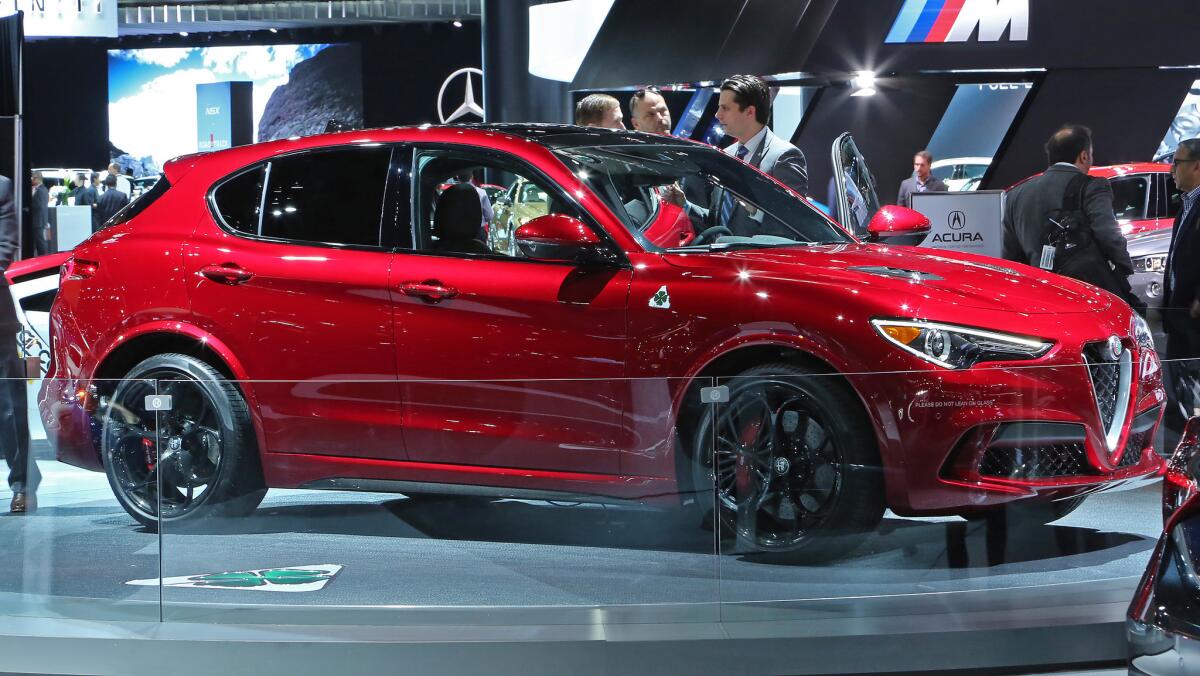
Bigland estimated that Maserati will sell 20,000 to 30,000 of the SUVs in 2017, and that Levante will account for 50% of all Maserati sales next year.
Some of the buyers are turning in their Porsche Cayennes, Bigland said. A surprising number are female – including a high percentage of single females, who are not generally the target customer for a high-end, full-size luxury SUV. (The Levantes start at $72,000, and the price goes up quickly with options.)
All is not rosy for the executive. As head of FCA’s U.S. and Canada sales, according to published reports, he is at the center of a U.S. criminal investigation into whether the company had inflated sales figures in the past.
Bigland said he did not think there was any danger that the introduction of an Alfa Romeo SUV would eat into sales of its Maserati counterpart. Both vehicles are powered by engines derived from the companies’ partnerships with Ferrari, and both are long on Italian styling and heritage.
But the Stelvio is a mid-sized performance SUV, boasting massive horsepower and sports car handling, that should appeal to a younger, less affluent buyer – the MSRP has not yet been announced – and the Levante is a full-sized luxury SUV that appears to appeal to a slightly older, more affluent buyer.
Although admitting the competition could create some agita for the U.S. sales divisions for the two brother brands, as head of all U.S. sales for both marquees, he isn’t worried personally.
“If someone comes in on a Levante, and goes out on a Stelvio, that’s not bad,” Bigland said.
The million-dollar Jaguar XKSS
This is the newly built version of Jaguar’s rare and classic XKSS sports car from the mid-1950s. The British automaker is producing only nine of the new versions and they’ve already been sold to collectors worldwide for about $1.3 million each.
We wouldn’t mind getting pulled over in one of these
A drive down memory lane?
A walk among the auto show’s vast display of custom cars can be a walk down memory lane.
Many vehicles at the L.A. Auto Show are throwbacks to bygone models.
Another standout: This sleek custom car inspired by the Pink Panther film and television series. It was created by George Barris, who was famous for designing many of Hollywood’s custom cars.
Scooby Doo and the Mystery Machine also made an appearance to conjure up some childhood memories.
This tricked-out Fiat 500, called Track Queen 1738, pays tribute to hip-hop artist Fetty Wap’s 2015 hit song “Trap Queen.”
With one headlight removed to feed air into the engine, the car looks like it has one eye, which reminded its designers of Fetty Wap. The Fiat was customized by Madness Autoworks.
And one more heroic custom job: This 2015 BMW i8 with a Spiderman paint job and custom doors that open up like wings. This model also has custom 22-inch wheels.
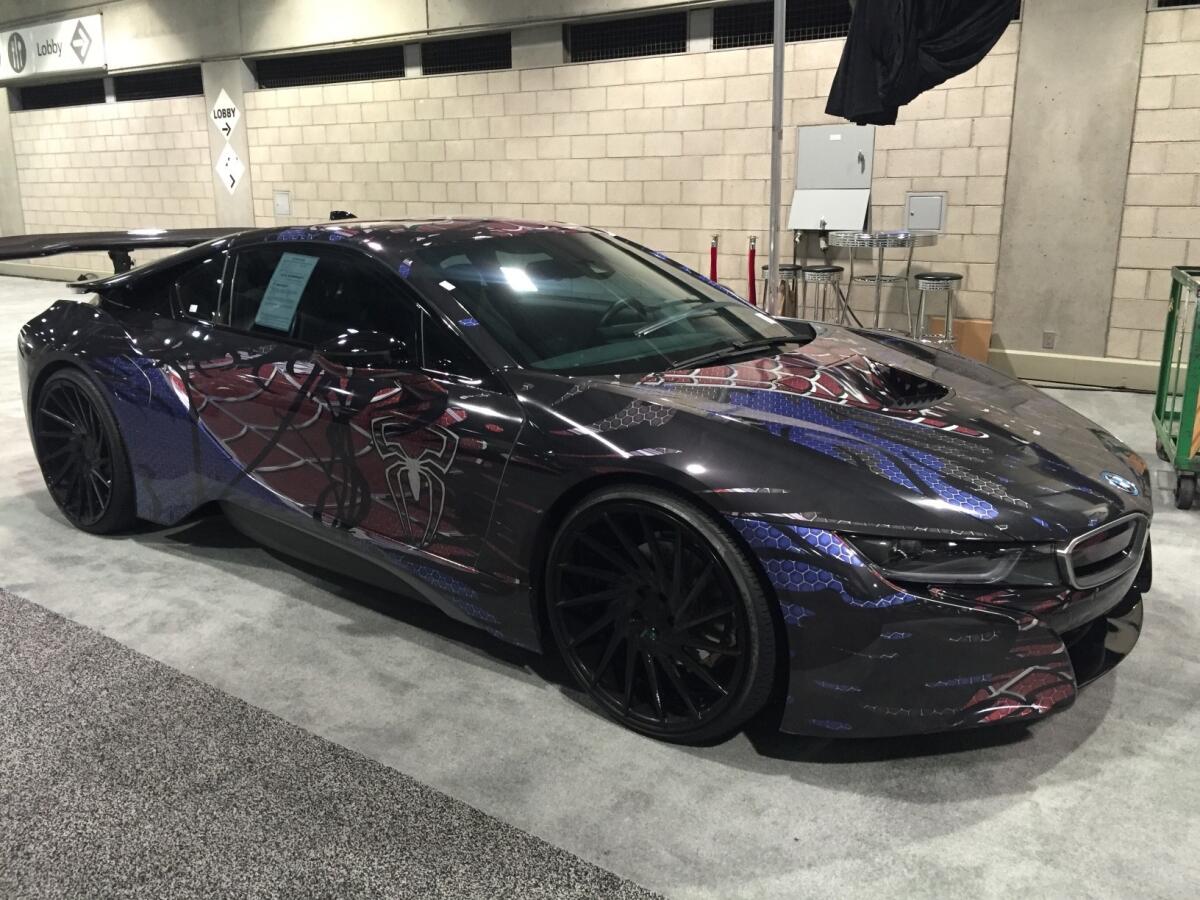
See more photos from the floor
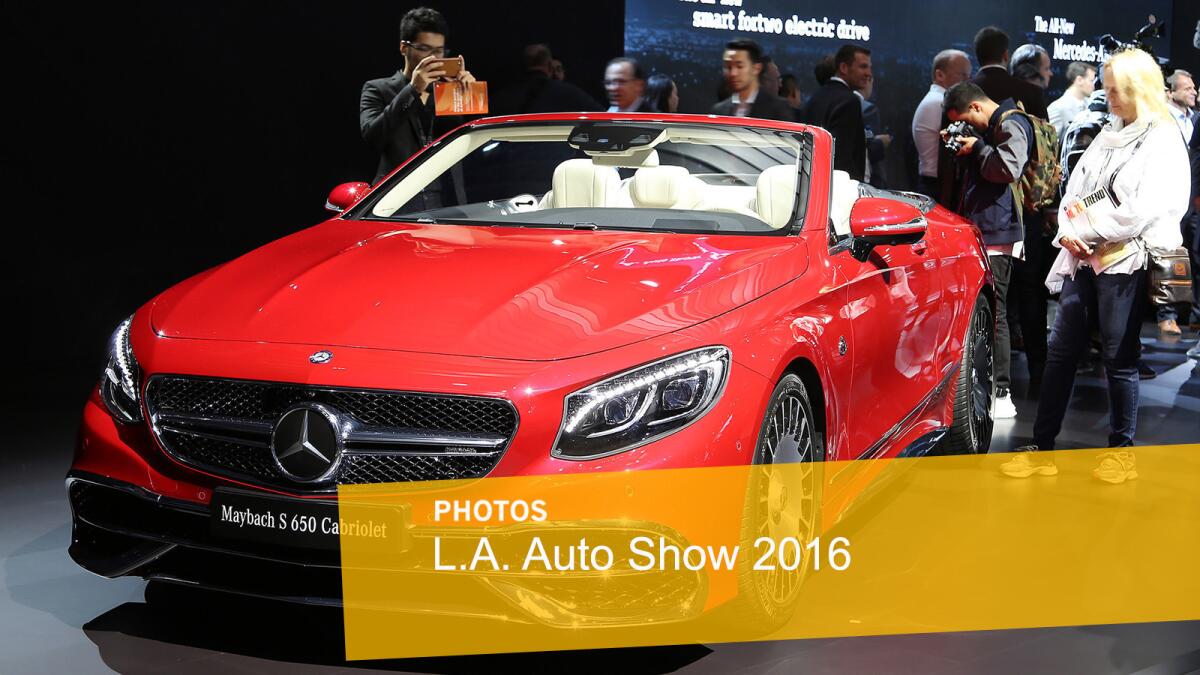
Auto Show regular Baron Margo shows off his latest creation, ‘Metamorphosis’
Silver Lake artist Baron Margo was back at the L.A. Auto Show this year, debuting the “Metamorphosis,” his latest whimsical creation. The car, which needs additional wiring before it can be driven, is something of a cross between an airplane and a boat, as Margo describes it, featuring portholes that open to the outside, a main cabin with a bed and a sink with a pump.
Margo, a master of Jules Verne-like automobiles, repurposes old parts from junk yards and scrap metal yards and, together with sheets of aluminum and copper, uses them to hand-make each vehicle. He works with a partner, Jaime Martinez.
The vehicles run on car or motorcycle engines that use regular gas.
While the cars are meant for driving, Margo said, first and foremost they’re art.
“My goal is simple,” Margo said. “To make something no one else has made.”
Margo and Martinez fund their work by selling earlier projects. But the cars are not for your average buyer: The Metamorphosis comes with a $400,000 price tag.
“I know you can buy nicer cars for $400,000,” Margo said, “but this isn’t just a car. You’re buying an art piece that you can drive in the street or put in a gallery, or even stick in your living room.”
This Porsche is electric ... literally
Hyundai Ioniq: Buy, lease … or subscribe?
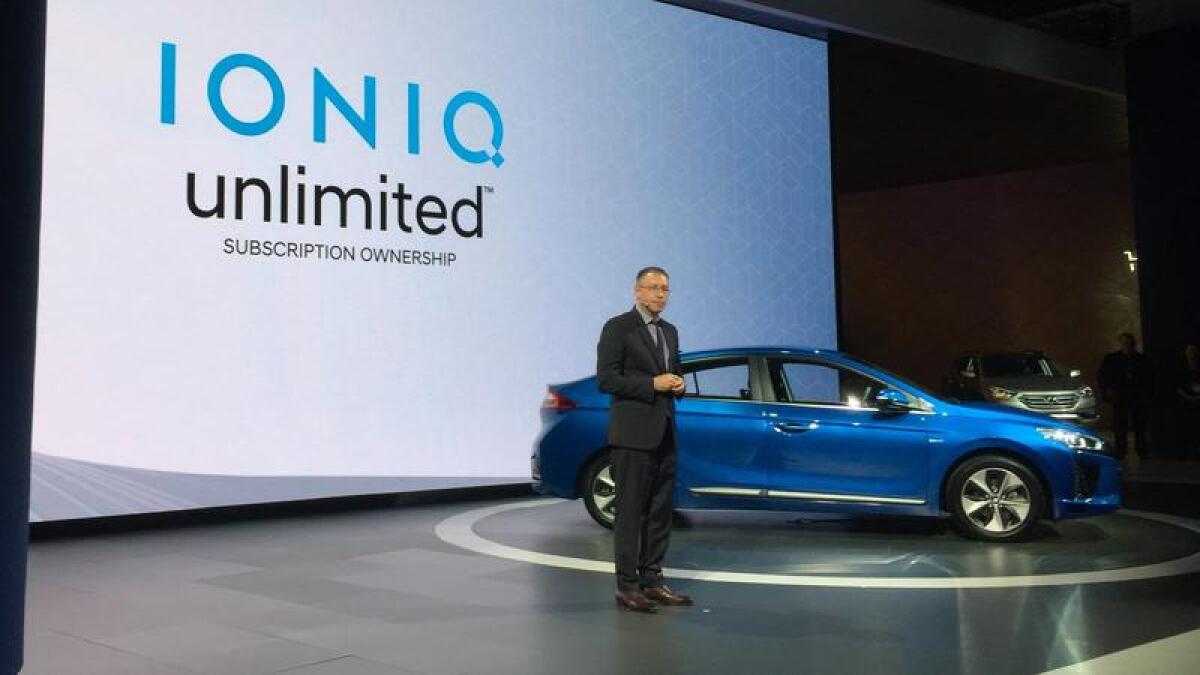
You can buy a car or lease a car. Soon you’ll be able to “subscribe” to one.
Hyundai’s new Prius-fighter, the Ioniq, goes on sale soon, eventually with three powertrains: hybrid, plug-in hybrid and all electric.
Starting next year in California, they’ll be offered for an as-yet unnamed subscription price, with no money down.
How they keep the cars smudge-free
Take a free spin during the L.A. Auto Show
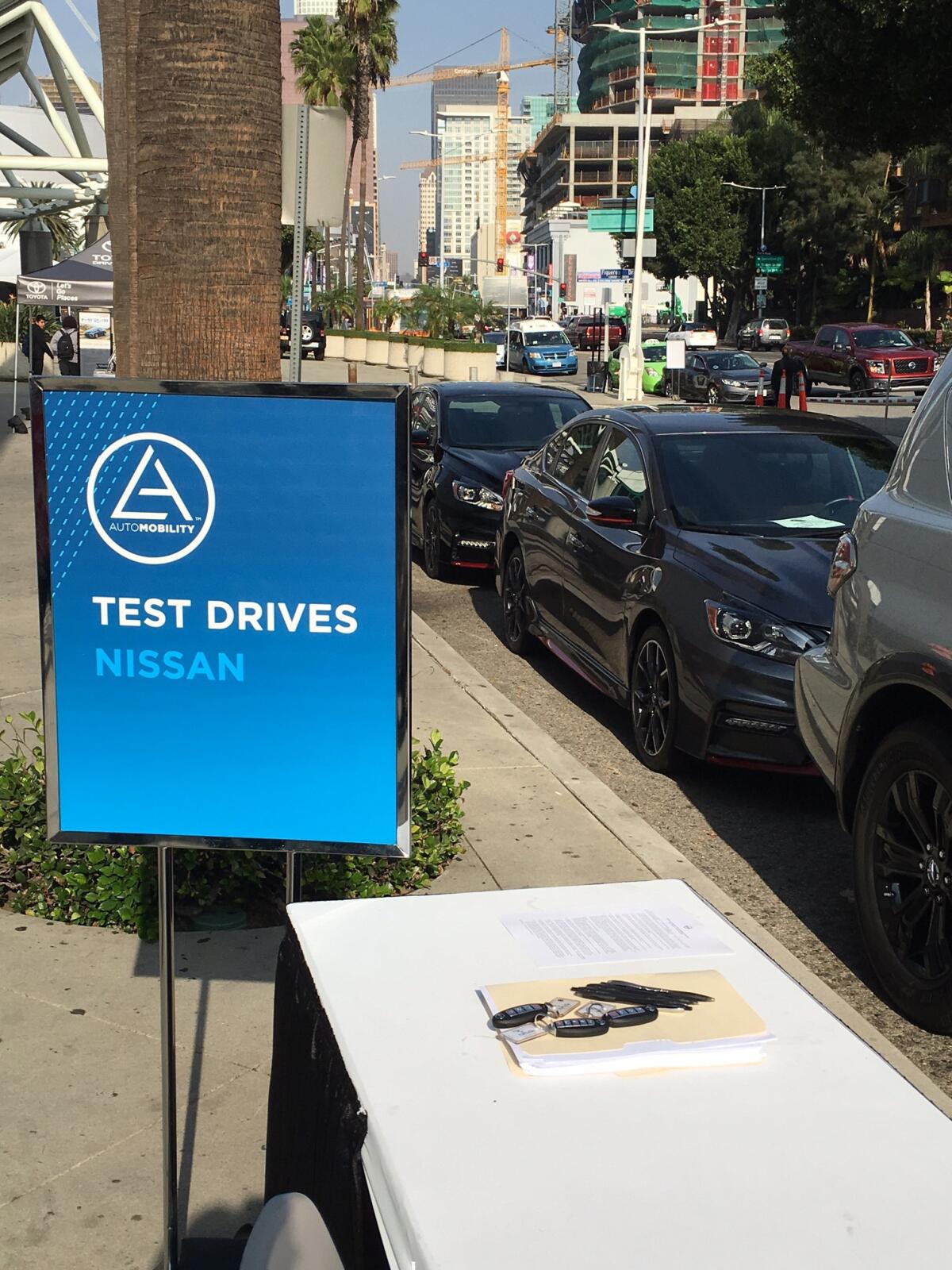
The L.A. Auto Show will again feature its “ride and drive” event where consumers can take a free test drive in one of nearly 100 brands of cars from about a dozen manufacturers.
“It’s one of the more popular things” at the show that runs from Friday through Nov. 27 at the Los Angeles Convention Center, said show spokeswoman Alexis Evans. “People love to test out what’s new and exciting.”
The rides are available all day and in front of the convention center on Figueroa Street. Consumers must present a valid driver’s license and their ticket to the show to participate.
A ride typically lasts 10 to 15 minutes and is limited to one consumer, who is accompanied by a representative from a dealership or the manufacturer.
“If there’s someone else you want in the back seat” such as a family member, “you’ll have to discuss that with the person doing the ride and drive,” Evans said.
The automakers involved in the drives include Honda, Toyota, Nissan, Mercedes-Benz, Kia, Volkswagen, Suburu, Fiat and Lincoln.
The 1,000-horsepower, ultra-luxury electric car you’ve never heard of
The name of the car is Lucid.
“It connotes clarity, transparency,” said Peter Rawlinson, chief technology officer. “We’re a California car company with a fresh California spirit.”
The Lucid, due out in late 2018, is a luxury electric car that kicks with 1,000 horsepower and runs from zero to 60 in under 3 seconds.
It will come in two models — one with a range over 300 miles, the other 400 miles or more, far more than any electric car on the road today or announced for the future.
Intended to prowl through crowded cities and sold around the world, it’s sized like an Mercedes E-class, but with all the room of an S-class interior. It’s a design made possible, according to Derek Jenkins, vice president of design, by proprietary battery technology that can be flexibly installed underneath to allow more space in the cabin.
If a buyer wants the option, the rear seats will recline like a business-class airline seat. Option or not, there’s plenty of legroom. “Part of the inspiration of our vehicle is the look and feel of an executive jet,” Rawlinson said.
The car will be packed with sensors for semi-autonomous and autonomous driving.
It will be expensive. The company isn’t talking price, but well over $100,000 is a safe guess.
“Think of it as the new paradigm for the environmentally conscious chairman of the board,” Rawlinson said.
The company plans to turn out 50,000 to 60,000 of these cars a year, however, and the company will set up a car-sharing arrangement so some buyers of lesser rank can better justify the costs.
Lucid is based in Menlo Park in Silicon Valley, not far from Tesla headquarters.
Rawlinson, by the way, was chief engineer at Tesla and was instrumental in the creation of the Model S.
Jenkins is a highly regarded designer best known for reviving Mazda’s design, including the MX-5 Miata.
If you are unfamiliar with Lucid, you’re not alone. “We’re the car company nobody ever heard of,” said Rawlinson.
It started out as a battery company named Atieva to sell batteries for buses and other commercial vehicles. It’s funded mainly by Chinese investors, including Jiu Yueting, who also is financing another electric car startup, Faraday Future, based in Gardena.
The car will be unveiled sometime next month. The site of its manufacturing facility is also expected to be announced soon.
Those attending the L.A. Auto Show might see a camouflaged Lucid make an appearance on surrounding streets.
FCA’s Alfa Romeo Stelvio is a sleek and sporty SUV
Alfa Romeo has joined the world’s automakers at last and introduced an SUV. The sleek and sporty four-door Stelvio, the FCA-owned Italian company promises, will deliver “best in class” performance that sacrifices nothing in comfort.
Nissan Rogue debuts to starfighters and dancing stormtroopers
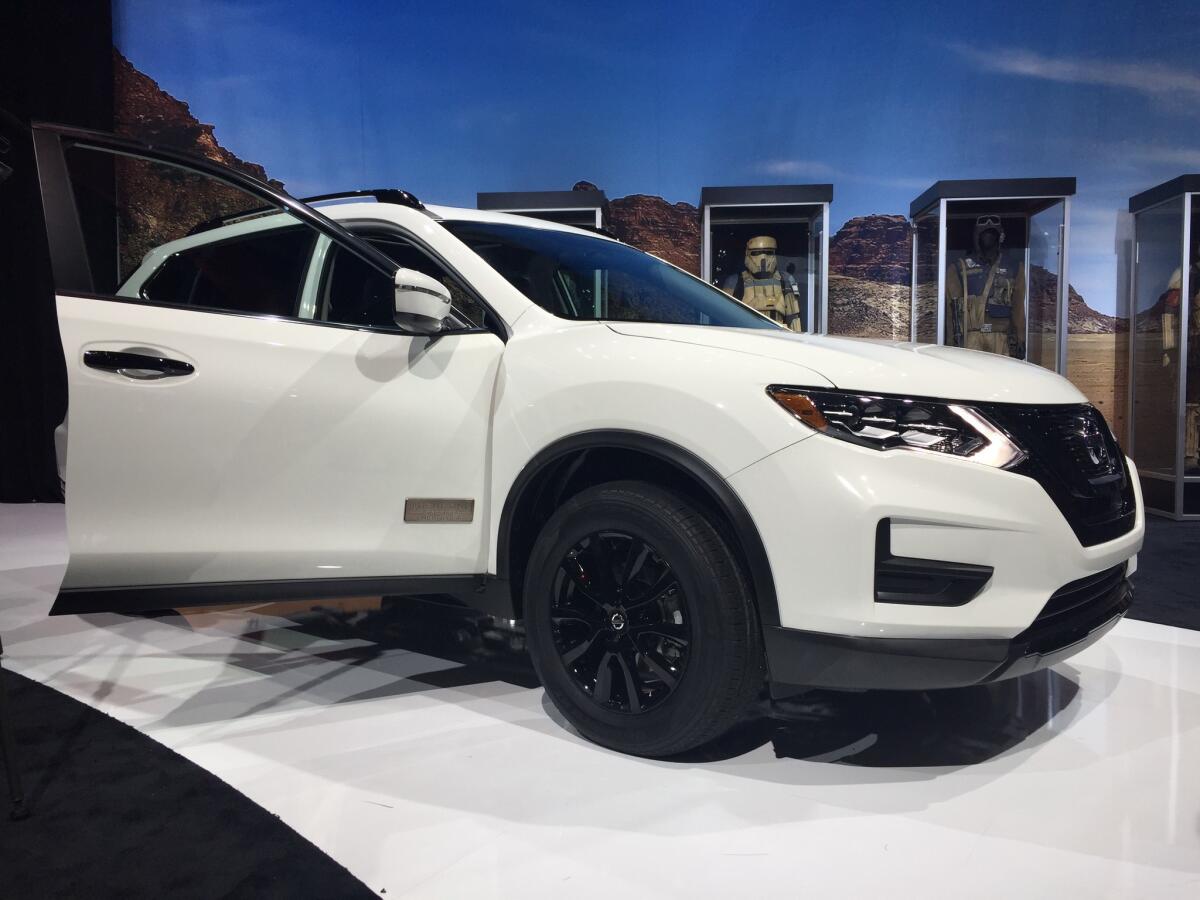
Standing tall amongst the hundreds of cars on display was a symbol of a galaxy far, far away.
The large replica TIE fighter of the “Star Wars” universe also marked the entrance to Nissan’s exhibit created for the unveiling of its Rogue One Star Wars car. In the midst of the reveal was a lone dancing stormtrooper that generated excitement through trivia and dance battles.
The unveiling of the Nissan Rogue: Rogue One Star Wars Edition is one of this year’s highlights at the L.A. Auto Show.
With only 5,400 models in production in the U.S. and Canada, the limited edition vehicle taps into the worldwide passion for the “Star Wars” franchise.
The car is emblazoned with “Star Wars” symbolism throughout and according to Phil O’Connor, chief marketing manager at Nissan. It’s the first time the “Star Wars” franchise put its official mark on a vehicle.
The vehicle will also come with a full-sized replica “Death Trooper” helmet, according to a company statement.
The release of the new Rogue coincides with the opening of the new film, “Rogue One: A Star Wars Story” in theaters next month.

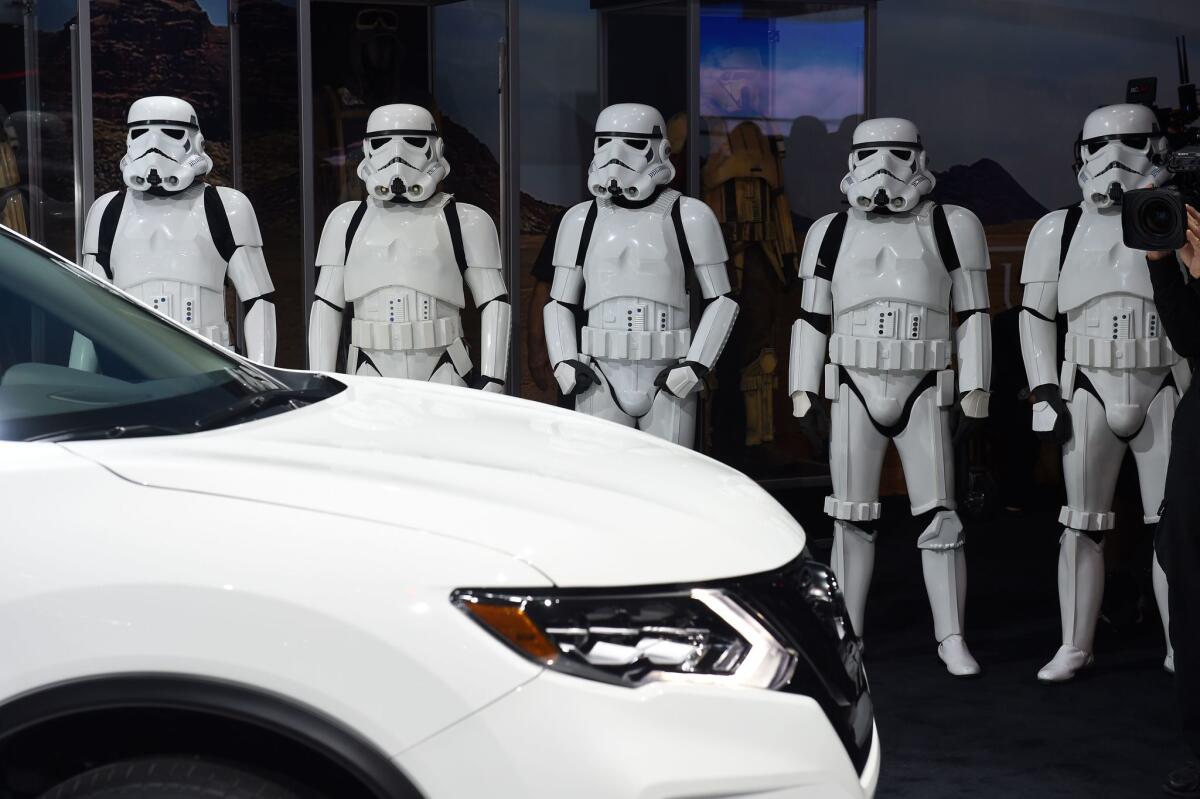
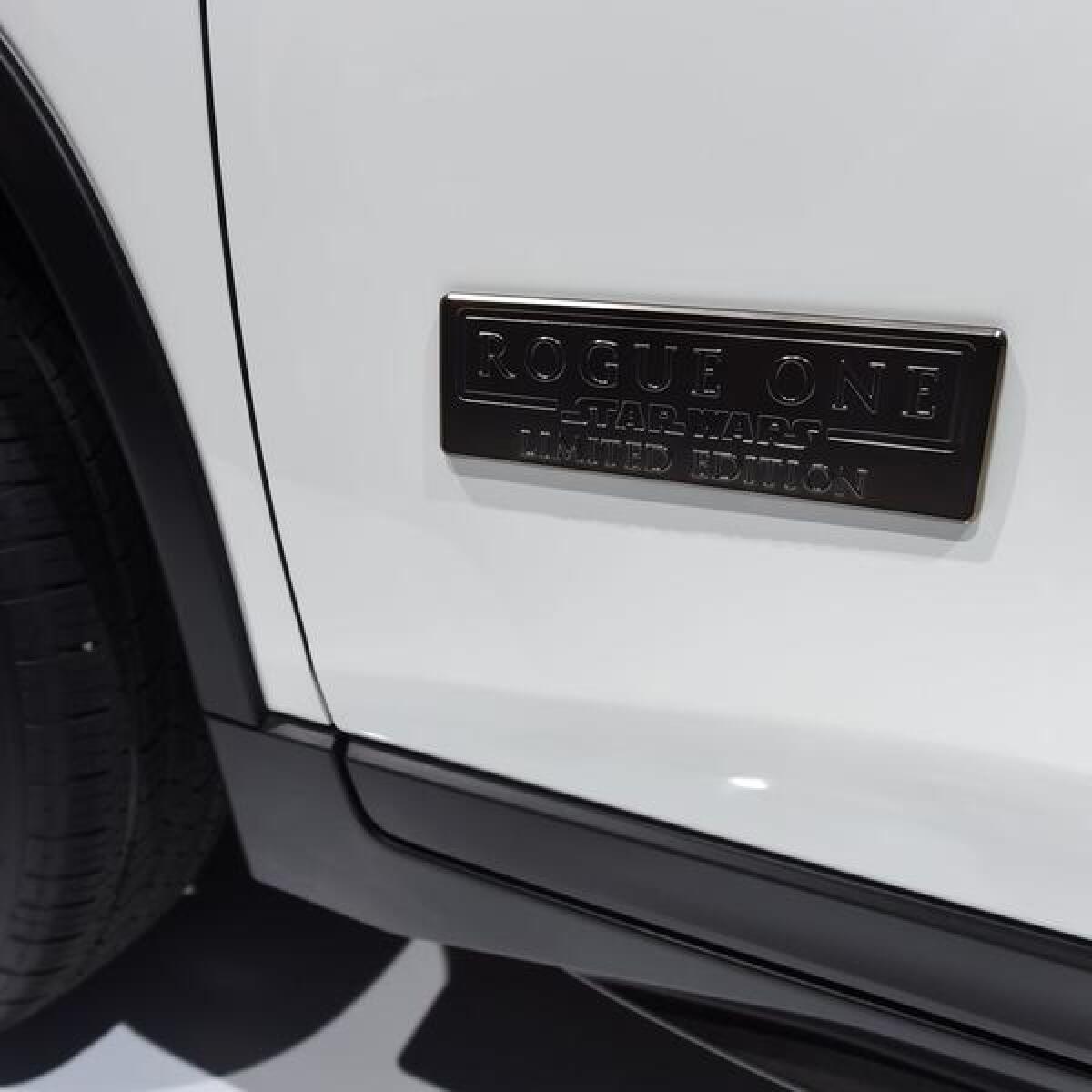
No more competition for an EV charging station?
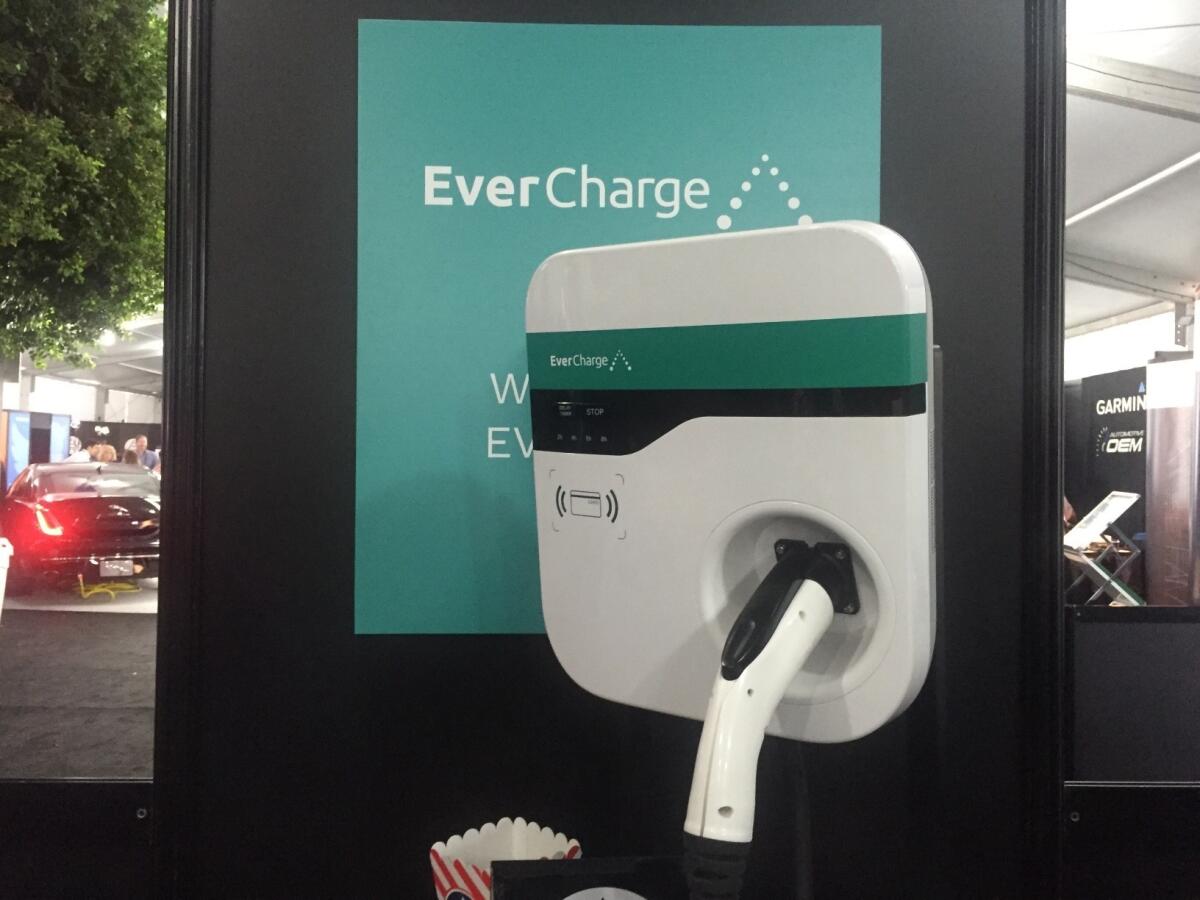
If you’ve ever left a passive-aggressive note on the windshield of a neighbor who parked in your building’s EV charging station stall overnight, EverCharge says it has a solution for you.
Designed for apartment buildings and condos, executives say, the “smart” EV charger maximizes a building’s existing power supply to charge more electric cars.
While most buildings can accommodate only two or three traditional charging stations without needing costly infrastructure upgrades, EverCharge uses the same power supply to accommodate up to 20 chargers, according to Joseph Nagle, the company’s marketing director.
And, he said, it learns your charging habits over time. Recognized by the L.A. Auto Show as one of the top 10 automotive start-ups, EverCharge operates in 28 cities, including Los Angeles, San Francisco, Seattle and Atlanta.
Start-up wants to tell your car’s dashboard where emergency vehicles are

Every year, thousands of ambulances are involved in car accidents, with many of them resulting in fatalities.
HAAS Alert wants to change that.
The Chicago-based start-up, which was named one of this year’s top-10 automotive startups at the L.A. Auto Show, tracks the location, speed, direction and even siren usage of emergency vehicles in real time. It then feeds that information to vehicle dashboards, navigation apps on mobile phones and even government agencies through an API.
“We look at it as a beneficial public service,” said HAAS Alert Chief Executive Cory Hohs, who founded the company in 2014 after almost being hit by an ambulance on his motorcycle. Not only can the service help avoid accidents and save lives, Hohs said, it can help cities save millions of dollars in costly litigation.
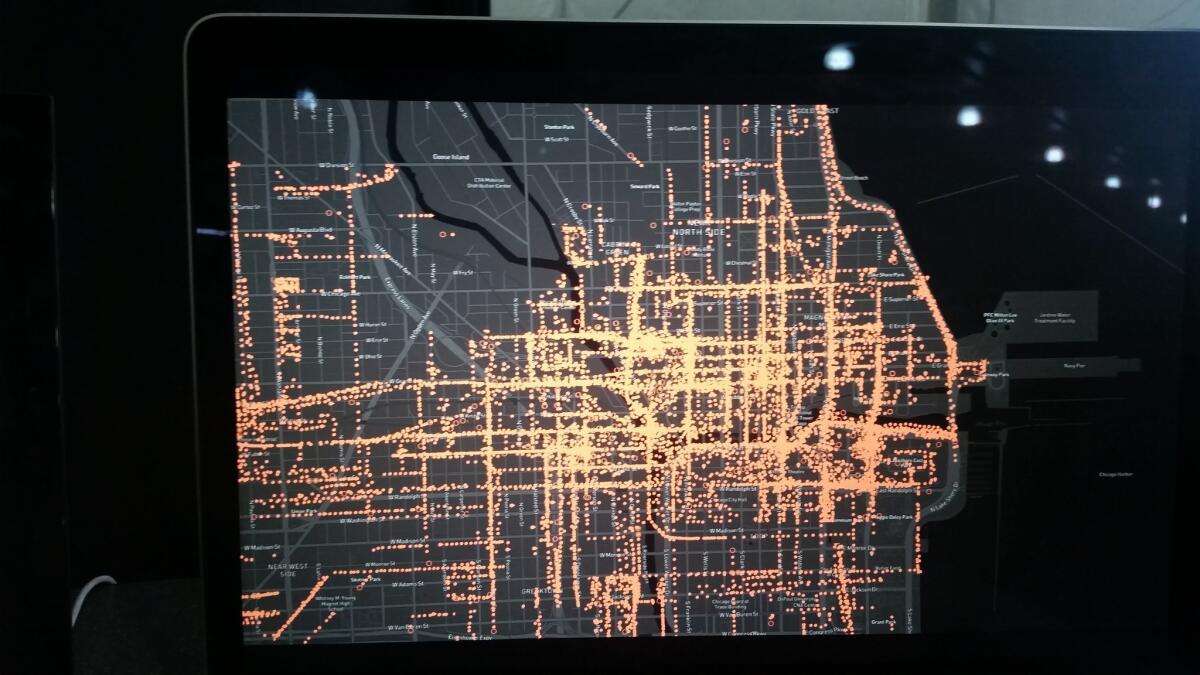
HAAS Alert is partnering with the city of Chicago to explore integrating HAAS’ data with the city’s traffic management system in order to, for example, adjust traffic signals in real time. Hohs said the company is also partnering with agencies in Palo Alto, Detroit and Grand Rapids, Mich., and is in talks with the Los Angeles Fire Department.
Hohs said that although he is proud of the public safety benefit of HAAS Alert, he is mainly targeting navigation apps and car manufacturers for revenue development. He said he hopes to get his product onto consumers’ mobile phones and, eventually, into self-driving cars that will automatically redirect based on the information provided by the app. “We want to get into services that users use every day,” he said.
Ford, Honda and the navigation app Inrix are already on board.
Porsche adds two hybrids to its Panamera line
Porsche is adding a pair of hybrids and an extended wheelbase to its line of Panamera luxury sports cars. The Panamera 4 E Hybrid Executive, making its world premiere at this week along with the Panamera Turbo Executive, will feature more horsepower, more performance and more amenities — and a higher MSRP — than previous Panameras.
Former Cisco Systems executive warns auto industry about narrow thinking

Over decades at Motorola and Cisco Systems, Padmasree Warrior saw how mobile phones and networking equipment became more powerful and feature-rich through software advances.
The auto industry is bracing for a similar revolution. But it won’t come if manufacturers focus on layering new software on traditional hardware, Warrior said.
For a car to become a digital device that people love as much as their smartphones, “the innovation has to come from software-defined hardware,” Warrior said during a keynote presentation at the L.A. Auto Show on Wednesday morning.
What she means, she said, is that features such as self-driving capability will only work if automakers reimagine how the technical components in cars work. And some automakers aren’t investing in that entire picture, she said. Silicon Valley specializes in the top layers of software, while Detroit automakers get the bottom layers, which are hardware.
But “the only companies that win in the future will be the ones that work on the entire stack,” Warrior said.
She didn’t say it specifically, but the implication was that Warrior’s new company, NextEV, is going down the right path. The electric car maker is expected to unveil its first vehicle next week. Warrior is the U.S. chief executive of the Chinese-founded start-up.
Mazda has a new CX-5
Mazda has come to the L.A. Auto Show with an updated, upmarket version of its top-selling crossover. The company says its four-door, five-passenger 2017 CX-5 will boast better handling, improved interior, a sportier look and the sort of premium paint found on top European cars.
Not quite a sedan, not quite a station wagon: Meet Audi’s A5 and S5 Sportback
Not quite a sedan, not quite a coupe and not exactly a station wagon, Audi’s four-door Sportback will come to the U.S. as a 2018 model in the A5 and S5 configurations. Until now available only in Europe, the new Sportback may fill a niche somewhere between the luxury sedan and the luxury SUV — a plush but practical alternative for city folks who don’t want to drive a road hog.
This rocket scientist is building cars that will someday fly over traffic
Morning commute got you down? Imagine flying over the worst parts of traffic, making a smooth landing and cruising into work or home.
That’s the sort of future Dezso Molnar, a rocket scientist and inventor of several flying car models, is working to create.
His latest model, the Molnar GT, has the speed and agility for road travel and the lightweight materials needed to help the vehicle soar.
As the population continues to grow, Molnar sees flying cars as an alternative travel option in densely populated areas.
“In the future, there’s not going to be any gas,” Molnar said at his L.A. Auto Show chat. “Congestion is only on the upswing.”
The flying car is not new. Molnar estimates that there have been about 100 flying cars throughout history.
In 2017, he will debut the flying car race, which will convene teams and their vehicles to compete, by air and by ground, between El Mirage Dry Lake and Border City, Nev. Molnar said he believes the competition will generate new ideas and future development, but for now you’ll have to keep enduring that L.A. commute.
Check out Molnar’s team testing another model, the Molnar G2, below:
Aston Martin mixes old with new on the Vanquish S
British carmaker Aston Martin has a new flagship. The Vanquish S Super GT, the second generation in the modern Vanquish line, is the company’s most powerful touring car.
This Civic Si prototype is Honda’s version of a serious sports car
One of the few manual stick shift cars at the L.A. Auto Show, Honda’s Civic Si prototype is the Japanese giant’s version of a serious sports car — right down to the high-performance racing tires and the Rallye Red Pearl paint job.
This chat bot wants to sell you a car — and make you feel like you’re talking to a real person
During an L.A. Auto Show press preview Tuesday, the automotive website Edmunds.com unveiled an advanced messaging platform to help prospective car buyers research vehicles and find dealers. The Edmunds chat bot, which is still in beta form, relies on Facebook’s Messenger app and on artificial intelligence to engage in conversations with potential customers, helping direct them to an appropriate dealer.
Nick Gorton, vice president of product innovation at Edmunds, said in the presentation that this type of chat service will allow customers to communicate in the way they prefer — increasingly, on mobile messaging apps — but still get the information they want. “We’re trying to meet customers where they are,” Gorton said.
“A.I. will free resources at the dealer [and] the consumer then really gets to control their time,” said Trace Przyblowicz, automotive lead for Facebook.
The bot would work as follows: A consumer sends a message, the bot responds with a personalized comment to make the consumer feel like he or she is talking to a real person, and then the two engage in a conversation about what kind of car the consumer is looking for. The bot offers search results from Edmunds’ inventory and directs the consumer to a nearby dealer. At some point, either because the consumer requests it or the bot gets stuck, the conversation gets converted to a live representative at the dealership, and that representative can then schedule a test drive or try to close the deal.
Audience reactions to the product seemed cautiously optimistic. Dealers asked how they could partner on the service, while others wondered about the possibility of spam (there is an opt-out feature), the security of information (it’s as secure as Messenger and the systems that dealers use to house customer data), and if the service would be available in other languages (not yet).
David Shapiro, the CEO of Cartelligent, a new car buying and leasing service, was skeptical that the platform would wholly transform automotive retail. “I don’t think we’re going to shift to buying cars through chat bots that use A.I. to respond,” he said. Shapiro said the chat bot might help dealers make money, but not necessarily offer a better customer experience. “Buying a car is complex — more complex than buying a pair of shoes or a plane ticket,” he said.
You won’t see Olli on highways, but in the future he may shuttle you around airports, college campuses and theme parks
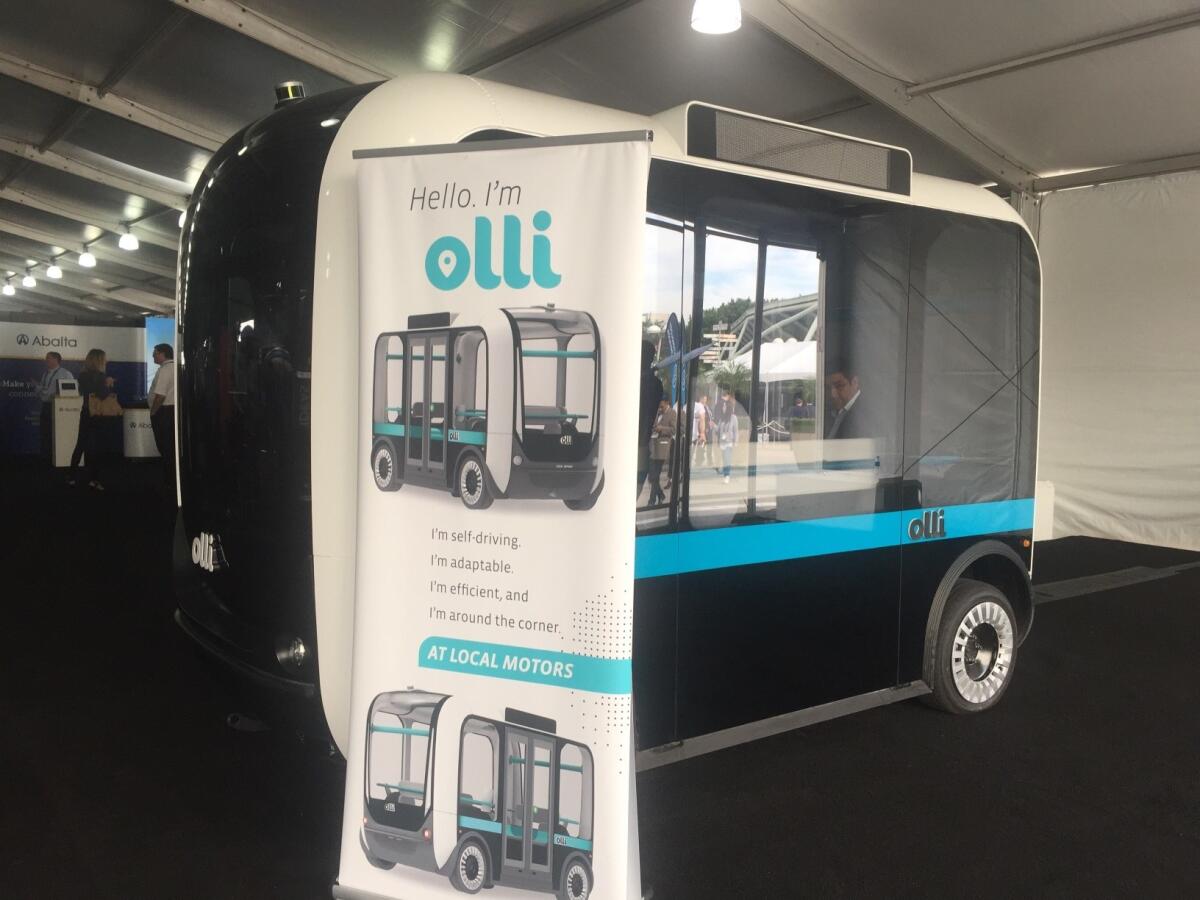
Autonomous vehicles are not novel. Places such as Northern California, Australia, and Singapore are already seeing models in use today. But Olli, a driverless 100% electric vehicle designed by Local Motors, is the first to tap into the power of IBM Watson.
Designed to transport up to 12 riders, Olli uses Watson’s cognitive computing capabilities to learn from data generated from sensors on the vehicle and encourage an interactive transit experience. Watson allows passengers to have conversations with Olli en route: The vehicle can understand and respond to questions.
Olli debuted this June and was born out of the 2015 Urban Mobility Challenge in Berlin. Contest winner and designer Edgar Sarmiento developed the concept for Olli, which can travel on predetermined or on-demand routes based on rider needs.
The vehicle, with a maximum speed of 25 mph, cannot travel on highways but is designed to fill transit gaps such as shuttling travelers at airports, giving students a lift on college campuses and dropping off theme park attendees at attractions, said Amy Rushia, senior director of marketing at Local Motors.
Local Motors recently sold some Olli units in Copenhagen and plans to announce its U.S. debut in next few months. Today, Olli is parked at the Auto Show technology pavilion entrance, and on Wednesday it will shuttle Local Motors Chief Executive Jay Rogers to his keynote address.
Human drivers will bully robot cars, says CEO of Mercedes-Benz USA

Dietmar Exler, chief executive of Mercedes-Benz USA, is often asked why it’s taking so long to develop self-driving cars.
It’s not technology, he tells them. That’s advancing fast.
It’s not insurance and liability issues. “I do believe in lawyers,” he said. “I’m a lawyer myself. We will solve these issues out.”
It’s not customer acceptance. As soon as someone rides in a car that can drive itself in bumper-to-bumper traffic, a convert is created, he said. “Who would argue that it’s fun to be out on the 10 between 5 and 6 p.m. on a weekday?
“The real issue,” he said, “is humans.”
The coexistence of human drivers and robot cars, to be precise. It’s not clear yet how well that will go.
Speaking at AutoConference LA, an event that runs at the same time as the L.A. Auto Show and that is co-hosted by J.D. Power and the National Automobile Dealers Assn., Exler said even if completely driverless cars were available now, they’d be sharing the road with traditional cars for 20 to 25 years.
Some people are afraid of robots taking over. Exler is worried that humans will “bully” driverless cars.
Human drivers already speed, drive erratically and cut in line. Driverless cars will be programmed to be polite and follow the law.
When someone tries to cut in line at a traffic merge, humans won’t let them in. But a driverless car will be programmed to stop when it sees an obstruction — like a line cutter. “They’ll look for the autonomous car and that’s where they’ll cut in,” he said.
Theoretically, robot cars could be programmed to be more aggressive, but he doubts regulators would allow that to happen.
Still, Mercedes-Benz is moving full speed ahead on semi-autonomous and driverless cars. The company was worried that its customers, who tend to love driving nice cars, would resist.
Market testing showed otherwise. Exler talked about a 72-year-old SLS AMG owner. He said he’d never use driverless technology because it would be “boring.”
But when he got a ride in a driverless S500 Mercedes in a Silicon Valley test zone, his response, according to Exler: “I will buy this car right now. How much do you want for it?”
Why walk when you can ride? Ford’s Carr-E prototype was made for the ‘last mile’ of your journey
It was built to take you – or your luggage – on the “last mile” of your journey: from the train station to your home, or the airport to your office.
Designed in Cologne, Germany, by engineer Kilian Vas, Ford’s Carr-E was one of 633 designs submitted by employees worldwide to the company’s Global Mobility Challenge, an internal contest for a device to help people handle city life.
Of the three winning designs, Carr-E is the only fully functional prototype. It’s too early, though, to say if or when it will hit the market.
About the size and shape of a car tire, the 25-pound, four-wheeled hoverboard-like device will slip right into your spare-tire storage space. One charge will carry 270 pounds up to 14 miles, at up to 11 miles per hour.
“Normally you’d have to walk this last distance,” Vas said. “With the Carr-E device, you can ride it.”
Feel like walking but don’t want to carry your luggage? No problem.
Using a wireless sensor device, Carr-E can follow you from up to nine meters away.
“It will do all the work for you,” Vas said. “If you stop, it will stop. If you go around the corner, it will go around the corner.”
To avoid a crash, though, be careful not to make your turns too tight.
The Mini Countryman — not so mini anymore
The Countryman, a four-door version of the Mini Cooper micro car, is known as “the big Mini.” A thorough revamp makes it a little larger. The bigger news: Besides two traditional gas engine versions, Mini next year will start selling an all-wheel-drive plug-in hybrid called the Mini Cooper SE Countryman All4.
Nissan adds a Sentra to its NISMO line
Nissan is adding a sporty Sentra to its collection of NISMO cars, the ones that get the company’s highest-performing engines, best steering and suspension, and wildest owners.
Intel CEO calls for automakers to buddy up on self-driving safety features

Businesses don’t like to share proprietary information with competitors. But for the sake of consumer safety, the auto industry should open up some self-driving car data, Intel Chief Executive Brian Krzanich said during a keynote address Tuesday.
Automakers point to trying to make roadways safer as the biggest reason for developing self-driving vehicles. But getting the technology right requires refining software that analyzes radar, camera and other sensor data. The thinking goes that the more data considered, the better the algorithm, the safer the car, Krzanich said.
How does a car react to a particular unsafe situation? The technical details of the response is the type of content Krzanich said the industry might want to gather in a central database. It should enable everyone to get the “fundamentals” right, he said, and companies individually can add redundancies and other safety measures that go above and beyond.
It’s unclear whether his message will find a receptive audience as automakers wrestle with how to gather and store the increasing amount of of performance, environment and user information produced within vehicles. Krzanich noted that in the coming years, a million self-driving cars in operation will be — in terms of data production — the equivalent of adding 3 billion people to the world.
Calling for data sharing is good for Intel because it offers technology for companies to store and share data online. It also could be good for the automotive start-ups that Intel’s investment arm expects to back with $250 million over the next several years. Access to the shared information could help those start-ups develop sensors and software much faster than they could working independently.
Take a spin on the Uni-Cub, Honda’s motorized ‘personal mover’
Honda’s Uni-Cub is a motorized personal mover developed by the company’s robotics group in Japan. Its lithium-ion battery can take the 18-pound Cub four miles at 4 mph, but it’s not available for sale yet.
With the ReachNow app, you can order up a ride in a BMW or Mini
Steve Banfield, chief executive of BMW ReachNow, wants to make one thing clear. “We’re not just a ride-sharing service!” he said at the L.A. Auto Show.
It’s not competing with Uber, either. But it’s making rides in BMW and Mini cars a lot more accessible to people who don’t own them.
Starting in December, in Seattle, users of the ReachNow smartphone app will be able to order up a ride in a BMW or share a car with a Mini owner through a peer-to-peer car sharing service. Starting early in 2017, they’ll be able to rent a BMW in Seattle for two to five days.
Those programs will be expanded next to Brooklyn. Future cities were not announced.
ReachNow, a BMW subsidiary, also announced a “fleet-sharing” program at a Manhattan apartment building, the Solaire, where residents will have access to 3-series BMWs and all-electric BMW i3s, parked on premises, with plans to expand to other residential high-rises.
The intention is not to compete with Uber. It’s in large part a marketing campaign: “People will have a chance to get in a BMW or Mini,” Banfield said.
To make cars lighter, automakers are dropping the spare tire
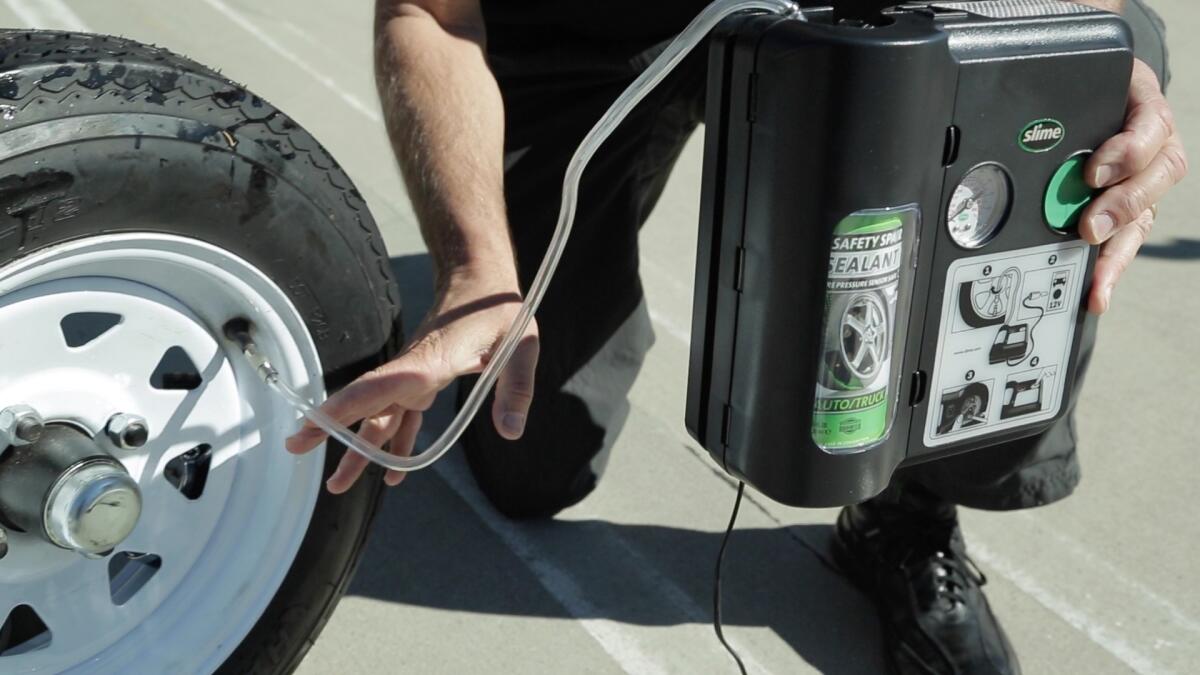
An increasing number of new cars are sold without a full-size spare tire. A surprising number don’t even come with “run-flats” or a temporary “donut” spare tire.
It’s not that the manufacturers are cheap. Most car companies, under the gun to improve fuel economy, are removing spare tires to cut weight in the vehicle. Using a repair kit to replace a full-size spare, and the accompanying lug wrench and car jack required to install it, can save up to 100 pounds.
“Automakers are trying to eke out every single mile per gallon that they can,” said Ron Montoya, Edmunds.com’s senior consumer advice editor. “It’s also a cost issue and a question of trying to increase the trunk space.”
‘Here comes that punk. Alexa, lock my Elantra!’
Freezing cold outside? Ice on the windshield? Tell Alexa to start up your Hyundai and set the defroster to 85. See that punk teenager with the skateboard headed toward your house again at night? Tell Alexa to lock the car door.
Hyundai and Amazon announced “Blue Link Skill for Amazon Alexa” which the home appliance voice recognition system can communicate with late-model Hyundais.
Hyundai, the Korean automaker, said the system will be integrated with its upcoming line of Prius-fighters, the Ioniq, which will be available as a hybrid, a plug-in hybrid, and an all-electric car.
You could tell your car to start charging, for example, when utility rates are lower.
Amazon is also working with Ford and BMW on similar deals.
Roomy Land Rover Discovery gets ‘most significant redesign’ in its history
This is a full-size 2017 sport utility vehicle from Land Rover, and the British automaker says the SUV is an all-terrain vehicle with optional seating for up to seven adults and priced starting at $49,990 before delivery charges and other fees.
The new Discovery is “the most significant redesign in the iconic SUV’s history,” Edmunds.com declared, with a less boxy shape, luxurious interior and an emphasis on versatility. If the two rows of backseats are folded down, the storage space totals 77 cubic feet.
The disappearing stick shift: Less than 3% of cars sold in the U.S. have manual transmissions

Visitors to the upcoming Los Angeles Auto Show will see supercars, hoverboards, self-propelling luggage and all manner of new transportation options.
But they’ll be hard pressed to find a clutch pedal or a stick shift. Available in nearly half of new models in the U.S. a decade ago, the manual transmission is going the way of the rumble seat, with stick availability falling to about a quarter this year.
Once standard equipment on all motor vehicles, preferred for its dependability, fuel efficiency and sporty characteristics, the four-on-the-floor and the three-on-the-tree are disappearing from major car manufacturers’ lineups — and subsequently from the sprawling auto show’s floors.
It’s a disgrace. Yes, it’s more troublesome and expensive for the automakers. But it’s completely inexcusable that Ferrari doesn’t even offer a manual.
— Karl Brauer, Kelley Blue Book senior analyst
The Ford EcoSport is a high-tech playroom
A subcompact crossover packed with technology. Or maybe it’s a high-tech playroom that happens to move people around. Ford’s putting the focus on features more than the vehicle itself. It’s aimed at people “choosing to spend their time and money sharing experiences with friends and family instead of buying more stuff,” Ford said. It “keeps you connected with family and friends when on the move.”
Ford CEO: ‘We are on the cusp of a mobility revolution’
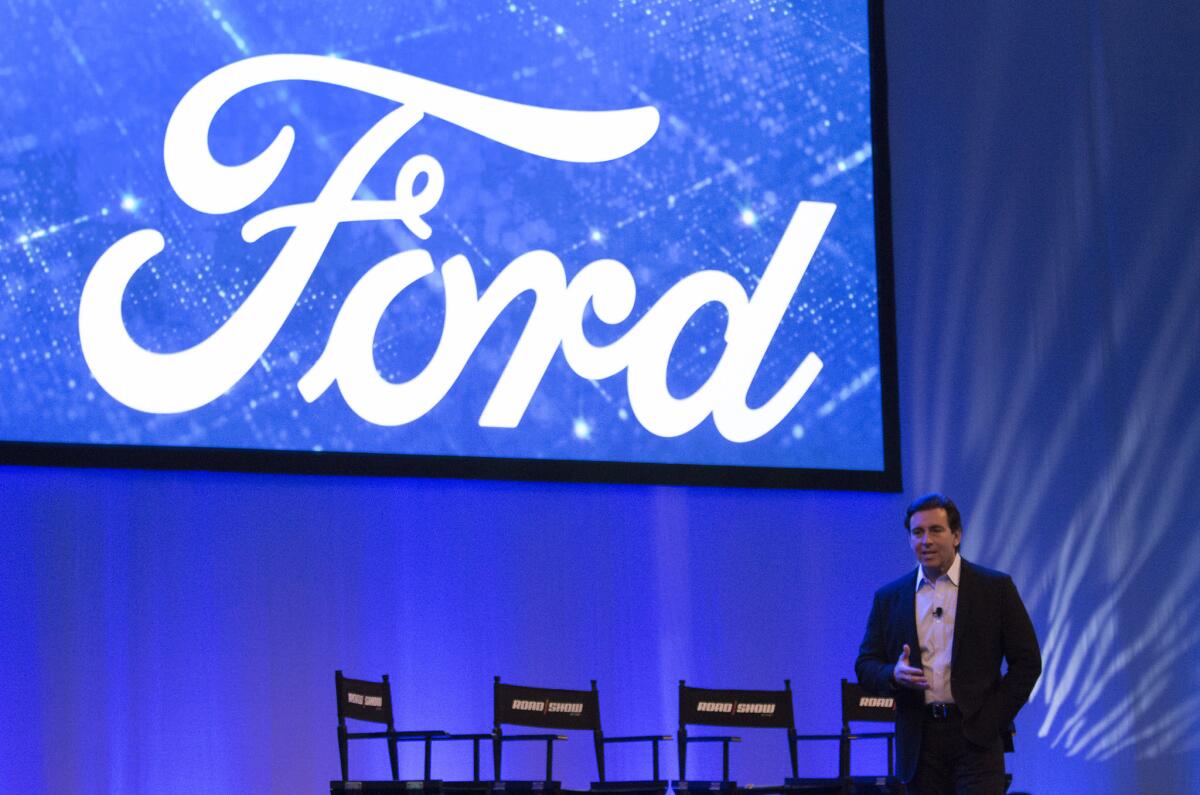
Embracing rather than fleeing from a mobility future that will almost certainly not include the automotive industry in its current formulation, Ford CEO Mark Fields told attendees of the just-convened AutoMobility LA car convention that his company is running headlong into an era in which cars are no longer Ford’s principal business.
“We are on the cusp of a mobility revolution,” said Fields. “While we will continue to make great vehicles, they are no longer our entire game.”
Speaking to an audience of about 300 industry professionals, wearing a blazer and open-necked dress shirt, Fields lauded the Los Angeles Auto Show executives for rebranding the industry-only portion of their annual event as AutoMobility -- and for stepping toward a future that, so far, no one can quite define.
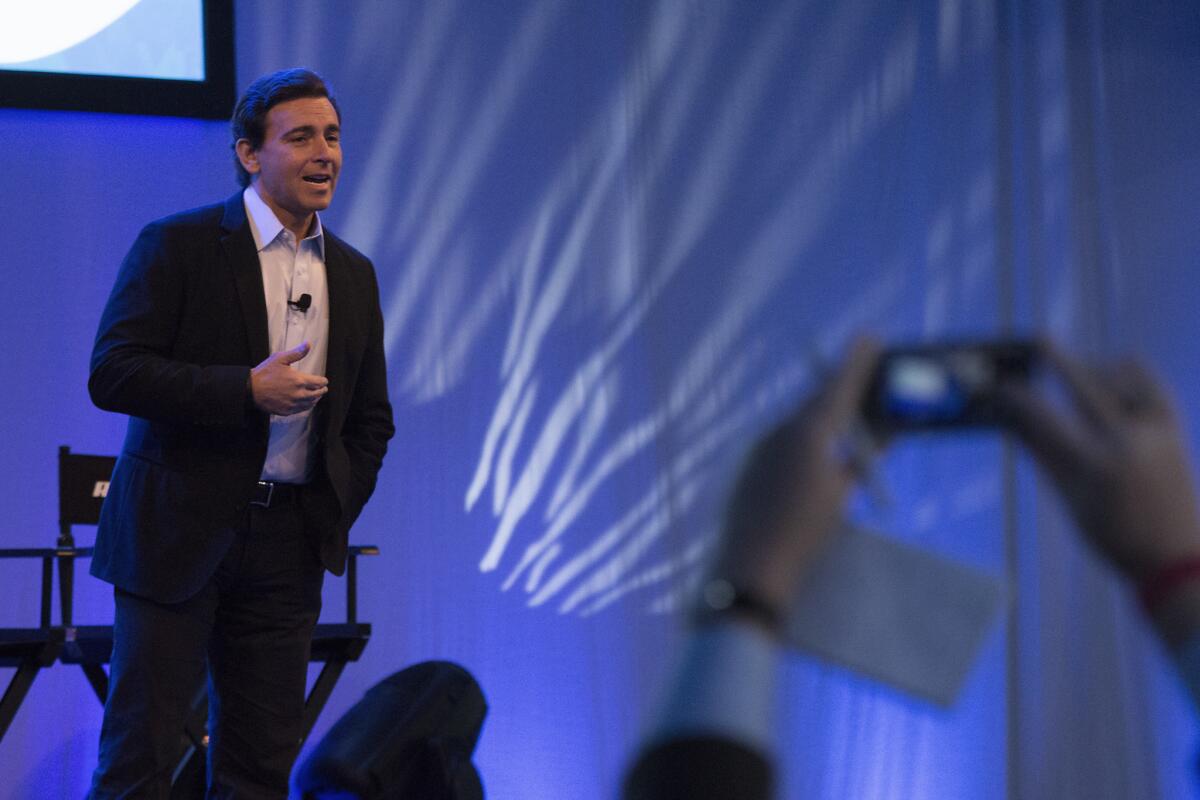
“We are attending the first major automotive show in the world that isn’t just about cars,” Fields said.
The CEO said the company’s future will depend upon cooperation with cities, among other things, to design transportation solutions for metropolitan areas. Characterizing this as “optimizing roads for the number of people on them, not the number of vehicles on them,” Fields stressed partnerships such as Ford’s with the urban shuttle service Chariot as key to future solutions.
He also said that his company will have autonomous cars on the road, in partnership with a ride sharing service, by 2021.
He also announced a partnership between Ford and former New York mayor Michael Bloomberg to work with cities to solve mobility problems.
Raising the spectre of company founder Henry Ford’s successful attempt to liberate working Americans from the personal mobility system known as the horse by introducing an affordable automobile, a century ago, Fields said, “We’ve spent the last 100 years getting ready for this moment.”
What to expect if you go to the L.A. Auto Show

The L.A. Auto Show kicks off today
What is it: The Los Angeles Auto Show runs from Friday to Nov. 27 and is one of the world’s most influential and best-attended auto shows. Hundreds of thousands are expected to attend the event, which will include new car reveals, test drives, the latest in automotive technology and other personal mobility advancements.
Where: Los Angeles Convention Center at 1201 S. Figueroa St.
Tickets: Advance tickets are available online at laautoshow.com. General admission starts at $5.
Children: Free for kids under the age of 6 if accompanied by a paying adult.
Parking: $20-$25 at the convention center. Available on a limited basis at South and West Halls.
Show floor: More than 870,000 square feet.
Show hours:
Friday, Nov. 18 9 a.m. – 10 p.m.
Saturday, Nov. 19 9 a.m. – 10 p.m.
Sunday, Nov. 20 9 a.m. – 9 p.m.
Monday, Nov. 21 10 a.m. – 9 p.m.
Tuesday, Nov. 22 10 a.m. – 9 p.m.
Wednesday, Nov. 23 10 a.m. – 10 p.m.
Thursday, Nov. 24 9 a.m. – 6 p.m.
Friday, Nov. 25 9 a.m. – 10 p.m.
Saturday, Nov. 26 9 a.m. – 10 p.m.
Sunday, Nov. 27 9 a.m. – 7 p.m.
Bag policy: Bags, purses, backpacks, camera bags and diaper bags larger than 12 x 15 x 6 will not be allowed inside the show.
Jaguar leaps into the all-electric market with an SUV: The I-PACE Concept
This is the first all-electric vehicle from the luxury carmaker, a production concept sport-utility vehicle that will become available in 2018. The production version will be unveiled late next year.
Electric cars are less than 1% of the market. Yet automakers are pushing them big time. Why?
Admit it: You’ve thought about buying an electric car. If but for a fleeting moment, you considered the possibilities: Zero tailpipe emissions. No more oil changes, no more tune-ups. Cheap fuel. And it seems pretty cool.
Then, if you’re like most people, you set the idea aside.
That disconnect is apparent in the U.S., where all-electric vehicles account for less than 1% of new car sales. With gasoline prices low and stable, historically gas-guzzling pickup trucks, sport utility vehicles and crossovers are what Americans want to buy.
Yet at the Los Angeles Auto Show, which opens to the public Friday, Porsche, Mitsubishi, Jaguar and Mini will unveil their new all-electric models or electric concept cars.